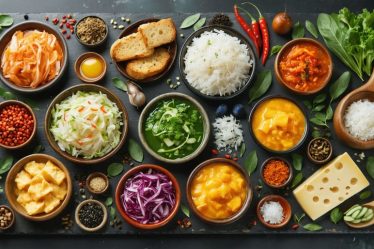
Picture a clay oven nestled in the heart of ancient Punjab, where the story of tandoori cooking began over 5,000 years ago. This cooking method, which has shaped our cultural identity through food traditions, represents one of humanity’s most ingenious culinary innovations. When archaeologists discovered the first tandoor ovens in Indus Valley settlements, they unearthed more than just cooking vessels – they found evidence of a revolutionary technique that would transform how we prepare food.
Imagine the scene: communal tandoors serving as gathering spots where families shared stories while bread baked on the clay walls and marinated meats sizzled, suspended over intense heat reaching up to 900°F. These cylindrical ovens weren’t just cooking implements; they were the heart of community life, weaving together sustenance and social bonds in a way that still resonates in modern kitchens worldwide.
The tandoor’s journey from ancient necessity to contemporary culinary star tells a story of innovation, preservation, and the timeless appeal of food cooked with fire and tradition. Whether you’re enjoying naan at your favorite restaurant or experimenting with tandoori recipes at home, you’re participating in a culinary legacy that spans millennia.
The Birth of Tandoor Cooking
Ancient Clay Ovens
Imagine walking through an ancient archaeological site and discovering something remarkably familiar – a clay oven that looks surprisingly like the tandoors we know today! These early clay ovens, dating back over 5,000 years, have been unearthed across the Indus Valley civilization, giving us a fascinating glimpse into our culinary ancestors’ ingenuity.
What I find particularly amazing is how these ancient ovens were built using locally available materials – primarily clay mixed with straw and animal hair for added strength. The cylindrical shape wasn’t just for aesthetics; it created the perfect environment for high-temperature cooking, something our predecessors figured out through generations of trial and error.
Archaeological findings in modern-day Pakistan and Northern India have revealed these ovens in various sizes, some as deep as five feet! They were typically built into the ground, using the earth’s natural insulation properties to maintain those intense cooking temperatures we associate with tandoori cooking today.
The clever design of these early ovens – with their round bottom and tapered top – created a natural convection effect, making them remarkably efficient for their time. It’s incredible to think that this basic yet brilliant design has remained largely unchanged for millennia!

From Necessity to Culinary Art
Like many great culinary traditions, tandoori cooking began as a simple solution to a basic need – preparing food efficiently with limited resources. What started as earthen pits dug into the ground gradually evolved into the cylindrical clay ovens we know today. As communities gathered around these communal cooking spaces, they began experimenting with different marinades, spices, and cooking techniques.
I remember my grandmother telling me how her mother would gather with neighborhood women to prepare tandoori rotis, sharing stories and recipes while the breads puffed up against the oven walls. This social aspect of tandoor cooking helped refine the techniques we cherish today. Skilled cooks discovered that yogurt-based marinades not only tenderized meat but also created that signature charred crust we love.
Over centuries, what began as a practical cooking method transformed into an art form. Chefs learned to control temperatures, perfect marination times, and master the delicate balance of spices. Today, tandoori cooking represents both a treasured tradition and a sophisticated culinary technique that continues to evolve while honoring its humble roots.
The Golden Age of Tandoori Cooking
Royal Influence
The enchanting story of tandoori cooking took a magnificent turn when it entered the royal kitchens of India. These palatial spaces weren’t just cooking areas; they were culinary laboratories where master chefs experimented with mindful cooking techniques that would forever change how we enjoy tandoori dishes.
Picture the bustling royal kitchens of Mughal emperors, where dozens of skilled khansamas (royal chefs) worked tirelessly to perfect tandoori recipes. They introduced exotic spices, developed complex marinades, and created signature dishes that would become legendary. The famous Tandoori Chicken, for instance, gained its royal stamp when it was prepared for the first time in the kitchens of Ranjit Singh, the Maharaja of Punjab.
What made royal tandoori cooking special was the attention to detail. Chefs would carefully select wood types for specific flavors, time the marination process precisely, and even consider the season’s impact on cooking temperatures. These refined techniques transformed humble clay ovens into instruments of culinary excellence.
The royal influence also brought about the tradition of using saffron and rose water in tandoori marinades, adding both color and aromatic complexity to the dishes. These elegant touches elevated tandoori cooking from simple sustenance to an art form worthy of kings and queens, creating a legacy that continues to inspire modern-day cooking.
The Birth of Tandoori Classics
Let me take you back to a magical moment in culinary history when tandoori cooking truly came into its own. Picture this: it’s the 1920s in Peshawar (now Pakistan), where a visionary named Kundan Lal Gujral was about to revolutionize Indian cuisine forever. In his restaurant, Moti Mahal, he experimented with marinating chicken in yogurt and spices before cooking it in the tandoor – and just like that, tandoori chicken was born!
The vibrant red color we associate with tandoori dishes wasn’t just for show. The signature hue came from kashmiri red chilies and turmeric, which not only added visual appeal but also packed powerful antioxidant properties. As women, we often appreciate how these traditional recipes combine beauty with wellness.
Alongside tandoori chicken, the tandoor gave birth to other beloved classics. Naan, that pillowy soft bread we all adore, found its perfect home in the tandoor’s intense heat. The high temperatures created those characteristic bubbles and charred spots that make each naan unique. My grandmother always said you could tell a perfect naan by the way it puffed up like a balloon in the tandoor.
These innovations spread rapidly across the Indian subcontinent, eventually becoming staples in restaurants worldwide. Today, these dishes represent not just delicious food, but a testament to human creativity and the endless possibilities that emerge when tradition meets innovation.

Modern Evolution and Global Impact
From Streets to Fine Dining
What was once a humble street food tradition has undergone a remarkable transformation in recent decades. Today’s innovative chefs have reimagined tandoori cooking to create an elevated dining experience that honors its authentic roots while embracing modern culinary techniques.
I recently visited a contemporary Indian restaurant where the traditional clay oven takes center stage in an open kitchen, allowing diners to witness the mesmerizing dance of flames and aromatic spices. It’s fascinating to see how restaurants have adapted this ancient cooking method while maintaining its essence – the distinct charred flavor and tender, juicy results that make tandoori dishes so special.
As someone who loves exploring different cuisines, I’ve noticed how understanding the fine dining essentials has helped chefs elevate tandoori cooking. They’ve introduced innovative plating techniques, refined spice blends, and creative fusion elements while preserving the authenticity that makes these dishes truly memorable. This evolution has helped introduce tandoori cooking to a whole new generation of food enthusiasts, proving that sometimes the most timeless traditions can shine even brighter in a modern setting.
Global Fusion
It’s incredible to see how tandoori cooking has found its way into kitchens worldwide, transforming from a traditional Indian method into a global culinary phenomenon. I remember the first time I discovered a tandoori-inspired pizza at a fusion restaurant – it was a delightful revelation of how ancient techniques can blend with modern tastes!
Today, you’ll find creative chefs incorporating tandoori flavors and cooking methods into everything from gourmet burgers to roasted vegetables. The signature smoky char and aromatic spices have become particularly popular in health-focused cooking, as the high-heat method requires minimal oil while maximizing flavor.
Restaurants across Europe and America have embraced tandoori-style cooking, often adapting the traditional clay oven concept to work with modern equipment. You might spot tandoori chicken tacos in Los Angeles or tandoori salmon in London’s finest establishments. Even home cooks are getting creative, using specialized grills and ovens to recreate that authentic tandoori taste in their own kitchens.
This global fusion hasn’t just exported Indian flavors – it’s created entirely new culinary categories that celebrate the best of both worlds.
The Magic of Tandoor: Why It’s Special

The Science Behind the Flavor
Have you ever wondered why tandoori dishes have that irresistible smoky flavor and tender texture that’s impossible to replicate in a regular oven? The magic lies in the unique properties of the tandoor, where science and culinary artistry come together beautifully.
Picture this: when the temperature inside a tandoor soars to 900°F (480°C), something remarkable happens. The intense heat creates a perfect storm of cooking methods all at once. The clay walls radiate heat evenly, while the circular shape creates a natural convection current, allowing hot air to circulate and cook food from all angles.
But here’s the real secret – as marinaded meats cook in this intense heat, their natural juices and marinade drip onto the hot coals below, creating flavorful smoke that rises and infuses the food with that characteristic tandoori taste. This process, known as flavor volatilization, is what gives tandoori dishes their distinctive smoky essence.
The high heat also triggers the Maillard reaction – that wonderful chemical process between proteins and sugars that creates those gorgeous brown crusts on the outside while sealing in moisture. It’s why tandoori chicken stays incredibly juicy inside while developing that beautiful charred exterior we all love.
The clay walls of the tandoor also play their part, absorbing and releasing moisture in a way that creates the perfect cooking environment. Think of it as nature’s pressure cooker, but with the added bonus of imparting earthy undertones to everything it cooks.
Health Benefits
When it comes to healthy cooking methods, tandoori stands out as a champion. I discovered this firsthand when I switched to tandoor cooking, and the difference was remarkable! The high-heat clay oven naturally seals in nutrients while allowing excess fat to drip away, giving you the perfect balance of flavor and health.
One of the biggest advantages of tandoori cooking is that it requires minimal oil, making it an excellent choice for those watching their calorie intake. The intense heat creates a natural barrier that keeps meat and vegetables juicy on the inside while developing that signature crispy exterior we all love.
The clay pot itself adds another layer of goodness. Traditional tandoors are made from natural clay, which is known to impart beneficial minerals to the food during cooking. Plus, the vertical cooking method means that when you’re preparing meats, the fat naturally drips down instead of pooling around your food.
For my health-conscious friends, you’ll be happy to know that tandoori cooking helps retain more vitamins and minerals compared to pan-frying or boiling. The quick cooking time at high temperatures preserves nutrients that might otherwise be lost through longer cooking methods. And here’s a lovely bonus – the smoky flavor that develops naturally means you need less salt and heavy seasonings to create delicious dishes.
As someone who loves both tradition and healthy eating, I find tandoori cooking offers the best of both worlds – authenticity and wellness working together beautifully.
As we wrap up our journey through the fascinating world of tandoori cooking, it’s impossible not to marvel at how this ancient cooking method has stood the test of time. From its humble beginnings in the Indus Valley to becoming a global culinary sensation, tandoori cooking continues to captivate food lovers worldwide.
What I find particularly remarkable is how this traditional cooking method has seamlessly adapted to modern times while maintaining its authentic charm. Today, you’ll find tandoori-inspired dishes not just in traditional Indian restaurants, but in fusion cuisines, food trucks, and even in our own home kitchens, where modern tandoor-style ovens have made this cooking method more accessible than ever.
The magic of tandoori cooking lies not just in its unique cooking method, but in the way it brings people together. Whether it’s a family gathering around a table of tandoori dishes or friends sharing stories over freshly baked naan, these meals create moments of connection that transcend cultural boundaries.
As we look to the future, tandoori cooking’s influence on global cuisine only continues to grow. Its emphasis on natural flavors, healthy cooking methods, and the art of slow food aligns perfectly with contemporary food trends. The tandoor’s legacy reminds us that sometimes the most enduring culinary traditions are those that combine simplicity with extraordinary results.



